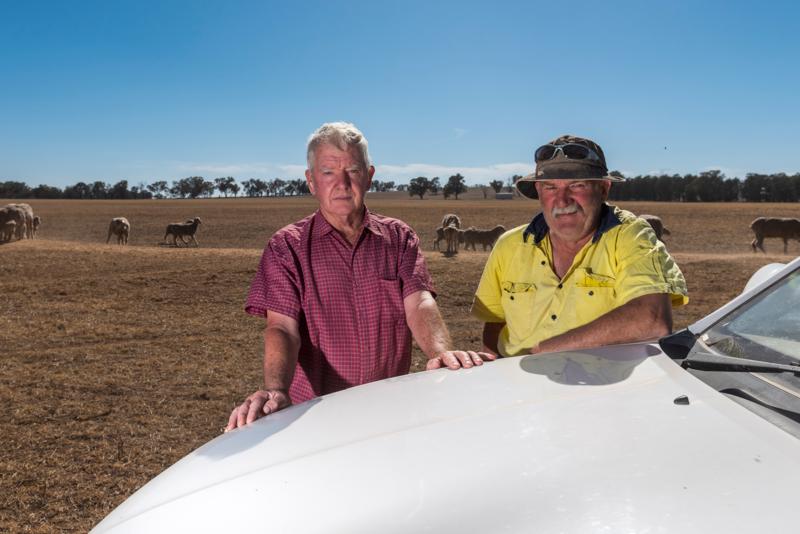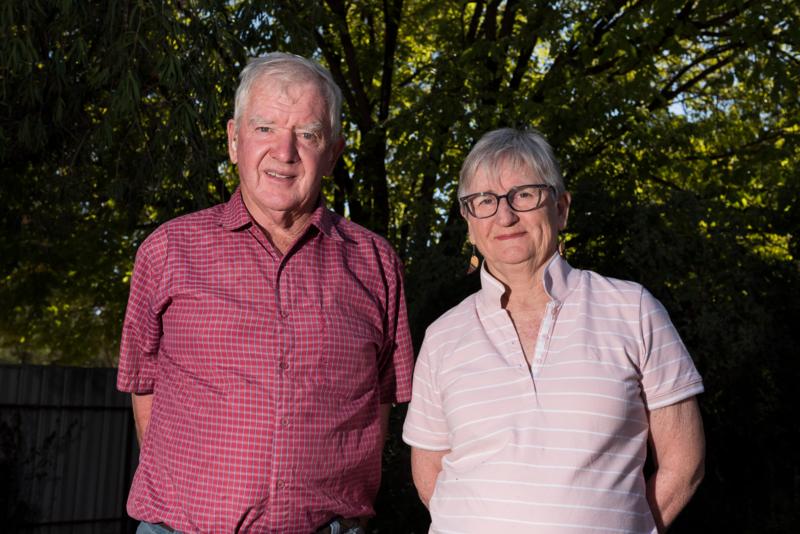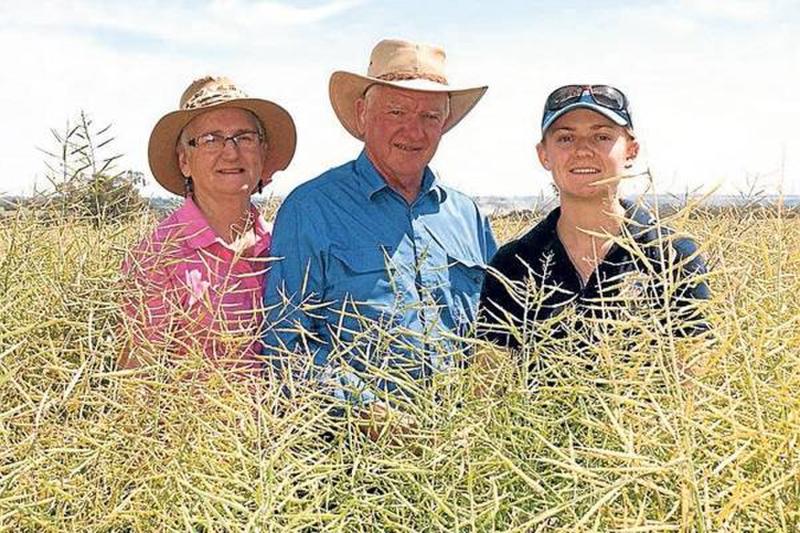AROUND Henty in the NSW Riverina, you can’t go very far before you hear about the Campbells. Third-generation farmer Peter Campbell and his wife Alison have been making a difference from their farm, Avondale, for almost 40 years.
Committed to the environment and to their local community, Peter and Alison have long been involved in local organisations and community projects to regenerate and beautify the area. Now in his late-60s, Peter spent many years on the Lockhart Shire Council, including as deputy mayor, and is chair of his local NSW Farmers branch of Billabong, which has just been named the 2018 Branch of the Year.
“Peter has been instrumental in keeping the branch active and providing opportunities for members to be involved,” says Daniel Brear, NSW Farmers’ regional services manager for the South West.
Alison is secretary of the Henty Community Bank Branch of the Bendigo Bank and recently retired from the catering committee of Australia’s premier mixed farming event, the Henty Machinery Field Days.
In 2012, the couple received the NSW Farmer of the Year award, recognising them for their environmental works and local involvement. “We were famous around here for about a day or so,” laughs Alison.
RELATED ARTICLES:
Mixed-farming family makes its mark over five generations
105 years of farming success in far-west NSW
Third generation farmers switch from sheep to cropping
For more than 100 years, there has been a Campbell farming at Avondale, which sits 17km west of Henty. Originally arriving as indentured labourers from Scotland in the 1850s, Peter’s grandfather Charles Campbell and his brother Lachie purchased property from the Scottish Australian Investment Company in 1914.
“They made their final payment for the land in 1918 and there is still a beautiful handwritten cash book from that time,” says Peter.
“Life would have been tough back then. My grandparents lived in a tent for the first two years and only built a small rammed-earth house after their first child arrived. The local school was two paddocks away and the school teacher boarded with them.”
Peter’s father, Colin Campbell, bought 263 hectares from his father and gradually added to it. “Dad was an innovator and a registered seed grower,” says Peter.
“He remained involved in the farm right up until his passing in 2002. It was a typical Merino sheep and wheat farm close to being self-sufficient. Paddocks were cultivated incessantly, and dust was ever present in the summers.”
Farm life was all Peter and his younger brother Bruce and sister Sue knew. When the children weren’t away at boarding school in Albury, they were helping out with all the farm chores, feeding the dogs, looking after the horses and moving stock.
Farm sustainability and profitability go hand in hand
“When I first moved to Avondale in 1984, it was about 1,550 acres [627ha] in three blocks,” recalls Alison. “Since then, we have progressively bought properties within a 15km radius of the base farm.”
Today, Peter and Alison work their 2,225ha of land with one full-time worker and a casual labourer. They developed a whole-farm plan more than 20 years ago. Water flow is controlled over the whole property, waterways are fenced off, windbreaks and shelter belts have been planted, laneways have been created for the sheep to move through, and reserves have been improved with an understorey to protect the wildlife.
 Peter Campbell with his farm manager Peter Sharp.
Peter Campbell with his farm manager Peter Sharp.
Much has changed since the horse-and-plough-days of Charlie and Lachie Campbell. “We’ve always kept up with mechanical technology and quickly went to a zero-tillage system so the soil is not disturbed,” says Alison. “Retaining stubbles, soil health and weed management are the key drivers of our cropping enterprise.”
Their fine Merino sheep are vital to the farming system, and managing good pastures is the key to the animals’ success. Cropping accounts for about 70% of the farm, but varies depending on profitability.
The farming system involves rotating lucerne, clover and cocksfoot pastures with the winter cropping operation. The aim is to maximise profit while at the same time carefully managing the natural resource base so it is sustainable. “Environmental sustainability is an ever-changing goal,” says Peter.
“I try to imagine our farm still being here 100 years, or even 1,000 years from now, and work towards maintaining it so that it can still be farmed productively in that time period.”
“It’s a challenge with the shallow topsoil we have, and it also includes a responsibility to native flora and fauna, particularly threatened species,” he says.
In the early 1990s, the Campbells managed a community project to regenerate a disused railway line that once ran from Henty to Urangeline East. “Two of our properties were dissected by this line, and it was an eyesore,” says Peter. “We fenced off both sections of the railway, replanted the area with local tree species and left it to grow.”
Later they added golden wattle, Dean’s wattle, silver wattle and punty bush to the corridor, creating a spine of trees that now runs through the properties. It has transformed the look of the farm and attracts a host of small birds, including weebills and honeyeaters.
“A well-planned farm with tree plantings, laneways and conservation works can add immeasurably to the enjoyment of farming,” says Peter. “Only last year I saw a superb fairy-wren at the farmhouse for the first time ever. We try to manage the foxes and cats, and have neighbours who are very happy to come spotlighting when necessary.”
Another project involved
releasing dung beetles and the Paterson’s curse bug. “Most of the dung beetles have moved to our neighbour’s cattle farms, but the other bug has been very busy eating Patto over the years,” says Alison.
 Grain and wool growers Peter and Alison Campbell on their property in Henty.
Grain and wool growers Peter and Alison Campbell on their property in Henty.
With the help of a grant and on-the-ground helpers from Greening Australia, the Campbells also established two native seed orchards with 10 different species that were collected and sold.
“More recently, we were the drivers of a project to restore a local laneway. We cleaned it up, planted trees, and put up nest boxes,” says Peter. Landcare, local schools and the
Wirraminna Environmental Education Centre all got involved, and they have taken the project further.
“The key to getting birds to come back is really quite simple. It’s about habitat restoration and good management. The project also hopes to enhance an area where sugar gliders have been identified.”
High commodity prices and smart farm management ease drought impact
While the current drought has been stressful, the luck of having planted the right crops in the right paddocks and having conserved moisture from the previous year has lessened its impact on the farm.
“We have had to reduce sheep numbers marginally, but the high wool and lamb prices right now make it worthwhile to continue to feed until shearing,” Peter says.
“The extreme heat of last summer has been memorable, but stock have survived. A few losses from hairy panic poisoning,” he says.
It’s the challenges of dealing with the different seasons, seeing the results of their production systems, and achieving their yearly goals that Peter and Alison say they love most about farming.
RELATED ARTICLES:
Horticulture growers at wits' end with drought
Tough lessons learnt: building resilience to drought
Drought survey: Farmers tell us how they are faring
The day the city woke up to the drought
Rural community leaders raise awareness for chronic fatigue syndrome
The pair have always been leaders in their community, but when their daughter Ainslie became ill, they were forced to take on their most serious project yet – raising awareness for myalgic encephalomyelitis, or chronic fatigue syndrome (ME/CFS).
After graduating from Charles Sturt University, Ainslie, now 30, fulfilled her dream of becoming a vet and began work in Victoria. Described as a “dynamo” and much-admired in her community, Ainslie was diagnosed with ME/CFS in early 2016.
As the illness progressed, she had no choice but to leave the job she loved and move back home to Avondale to be closer to family and carers. Her condition continued to worsen and now she is in the 24/7 care of her parents.
 Alison and Peter with Ainslie before their daughter’s diagnosis with ME/CFS. Source: Fairfax.
Alison and Peter with Ainslie before their daughter’s diagnosis with ME/CFS. Source: Fairfax.
Little is known about this complex, chronic neuroimmune illness. It affects up to 240,000 Australians and there is no cure. It has been devastating for family and friends to see the decline in Ainslie’s health and it has completely turned Peter and Alison’s lives around.
RELATED: Q fever battle: the boy we almost lost
“We are lobbying for greater awareness because currently there is no government funding into finding out what causes the disease or how to treat it,” says Peter.
When they began their awareness campaign, they were overwhelmed by the support they received and have so far raised $20,000 towards research into the condition.
 Ainslie wasn’t well enough to take part in our photoshoot, but shared a selfie with us taken in a darkened room as she can’t tolerate light, to raise awareness of her illness.
Ainslie wasn’t well enough to take part in our photoshoot, but shared a selfie with us taken in a darkened room as she can’t tolerate light, to raise awareness of her illness.
*To make a donation towards ME/CFS research, call Kay Schwarz at Griffith University on 07 5678 0938, or email [email protected], and mention the Campbells of Henty.